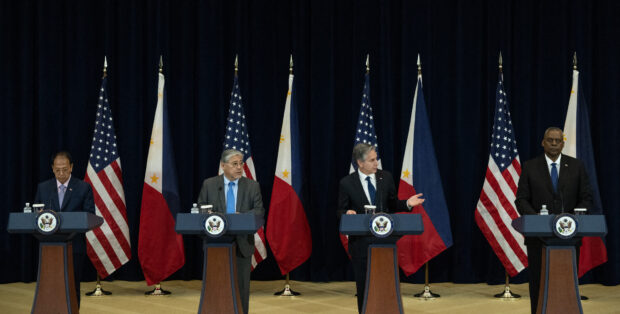US, PH chart defense aid in next 5 to 10 years

ROADMAP | At the 2+2 Ministerial Dialogue in Washington on April 11, (from left) acting Defense Secretary Carlito Galvez Jr., Foreign Secretary Enrique Manalo, US Secretary of State Antony
Blinken, and US Defense Secretary Lloyd Austin III agree to craft a roadmap on the long-term delivery of US military aid to Manila for the “shared defense” buildup of the two treaty allies. (Agence France-Presse)
MANILA, Philippines — The top defense and diplomatic officials from the Philippines and the United States agreed on Wednesday to finalize in the coming months the delivery schedule of American military equipment and other defense assistance to Manila over the next five to 10 years.
US Defense Secretary Lloyd Austin III said at a press briefing that the longtime allies, which share concerns about an increasingly assertive China, discussed the delivery of “priority defense platforms,” such as radars, drones, military transport aircraft, and coastal and air defense systems at the so-called 2+2 meeting in Washington that also involved US Secretary of State Antony Blinken, acting Defense Secretary Carlito Galvez Jr. and Foreign Secretary Enrique Manalo.
A joint statement said the “adoption of a Security Sector Assistance Roadmap in the coming months will guide shared defense modernization investments and inform the delivery of priority platforms over the next 5 to 10 years.”
According to the statement, the roadmap would “identify areas for capacity-building to enhance the Philippines’ core institutions and support security sector governance.”
It said the officials agreed to prioritize the modernization of “shared defense capabilities” through various means such as US foreign military financing and excess defense equipment to strengthen the country’s defense capabilities and capacity to resist coercion.
They also underscored the importance of fast-tracking discussions on an acquisition plan for a fleet of multirole fighter aircraft for the Philippine Air Force, which has been looking between Swedish-made Saab JAS-39 Gripen and American-made Lockheed Martin’s F-16 fighter planes as its shortlisted choices.
The officials also discussed the $100-million foreign military financing that Manila could use to buy medium-lift helicopters after its decision last year to scrap a P12.1-billion deal to buy transport helicopters from Russia.
The Philippines is the biggest recipient of US military assistance in the Indo-Pacific region.
The underfunded Armed Forces of the Philippines, one of the weakest in the region, has been trying to upgrade its capabilities in recent years with a meager budget.
The AFP failed to meet its target acquisitions for Horizon 2, or the second phase of its military’s capability upgrade program covering the years 2018 to 2022, due to funding issues. Horizon 3, or the final phase that started this year and will run until 2028, consists mostly of equipment geared for external defense, including maritime patrol aircraft and additional trainer aircraft.
Aside from boosting Manila’s defense capabilities, the Philippines and the United States agreed to fast-track ongoing discussions on new bilateral defense guidelines as well as the conclusion of a bilateral General Security of Military Information Agreement before the end of the year, to enable real-time information-sharing and technology cooperation across domains.
Manalo said the two allies “redoubled” their commitment to modernize the Philippines-US alliance “recognizing that our partnership will need to play a stronger role in preserving an international law-based international order” and welcomed Washington’s pledge to ramp up support for the modernization of Manila’s defense, law enforcement, disaster response capabilities, and implementation of Enhanced Defense Cooperation Agreement (Edca) projects.
Galvez said they recognized “the need to work together to enhance our interoperability, increase our defense capacity, and build our resilience against emerging challenges.”
Defense guidelines
Experts said the United States saw the Philippines as a potential location for rockets, missiles and artillery systems to counter a Chinese amphibious invasion of Taiwan, which China claims as its own.
Austin said that it was “too early” to discuss what assets the United States would like to station at Philippine military bases under the recently expanded Edca.
Manalo said the Edca sites were mainly aimed at improving military interoperability, addressing potential humanitarian disasters “and perhaps respond to other types of security challenges,” but did not elaborate.
The Pentagon has not specifically said what the additional sites would be used for, except that work would include airport expansion and training involving naval assets.
Manalo said on Monday that Washington and Manila would need to discuss what the United States may do with its access to the Edca sites.
Southeast Asia expert Greg Poling at Washington’s Center for Strategic and International Studies said the bilateral defense guidelines to be worked out by the two allies were aimed at providing strategic direction and to lay out each side’s responsibilities.
The Washington meeting came after more than 17,000 Philippine and US soldiers began their biggest ever joint military drills on Tuesday.
Emergency situations
US-Philippines relations have warmed considerably under President Marcos and the 2+2 meeting underlined that as the first of its kind in seven years.
On Monday, Mr. Marcos assured China that military bases accessible to the United States would not be used in offensive action, stressing that the arrangement with Washington was designed to boost his country’s defenses.
However, the AFP said on Wednesday that these sites could be used for “emergency situations” by Philippine and US troops.
At the Laging Handa briefing, AFP spokesperson Col. Medel Aguilar, asked how the new Edca locations would be used in case tensions erupt between Washington and Beijing over Taiwan. He said the Edca sites “will also be made available during the emergency situation for combined use of the US and AFP.”
The military official also dismissed criticisms from progressive groups that opening up more Edca sites would not bring any gains for the Philippines and would only put the country in danger.
“There will be a time that these facilities will be formally, well, completely turned over, its ownership and use to the [AFP]. So, we stand to benefit from the implementation of this Edca,” he said.
